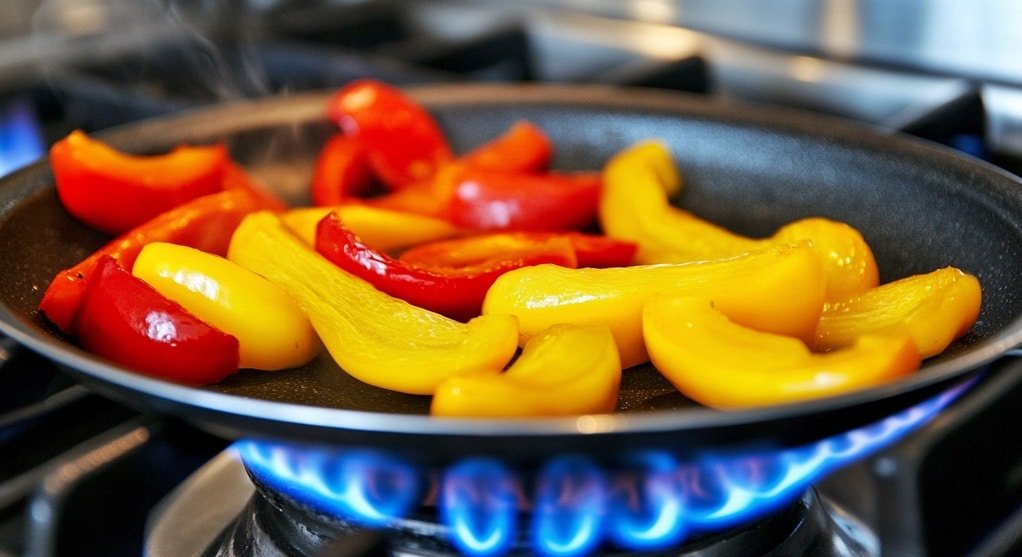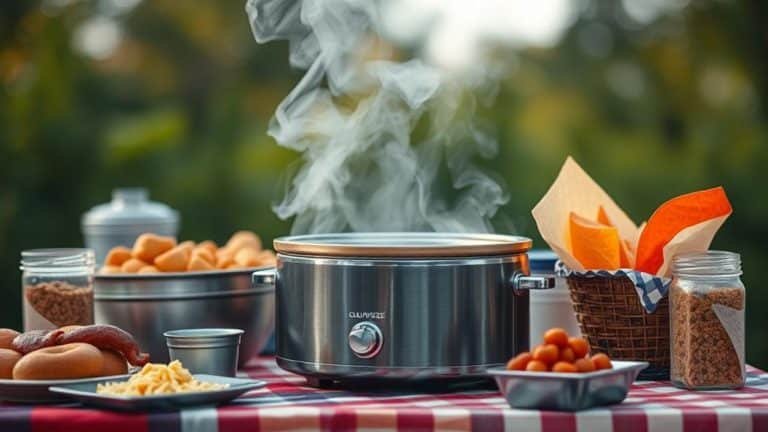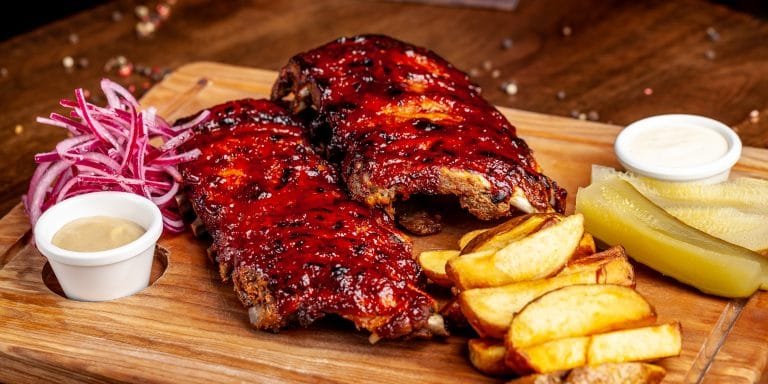Yes, nonstick frying pans can be safe for cooking if used properly. These pans are typically made from materials like aluminum or stainless steel, then coated with a compound called polytetrafluoroethylene (PTFE) to create a nonstick surface. While concerns were once associated with a chemical called PFOA, its use was phased out in 2013.
Regardless, you should avoid overheating your nonstick pans as this could lead to the release of toxic fumes. Always ensure good ventilation, and adhere to regular maintenance to prolong their efficiency and safety.
Cooking techniques that prioritize proper temperature and the use of specific utensils are essential for safe use. There’s more to learn about alternatives and their unique benefits.
Key Takeaways
- Nonstick pans, primarily made of PTFE, require careful maintenance to ensure safety and longevity.
- Overheating nonstick pans can release toxic fumes, leading to health risks like polymer fume fever.
- Since 2013, manufacturers have phased out PFOA, a concerning chemical once used in nonstick coatings.
- Safe use of nonstick pans involves medium or low heat settings, proper ventilation, and the use of gentle utensils.
- Alternative safe cookware options include stainless steel, cast iron, ceramic, and anodized aluminum, each with unique benefits.
Understanding Nonstick Cookware
While you may use nonstick cookware daily, you mightn’t be fully aware of what it’s made of and how its nonstick properties work. Nonstick coatings, primarily made from a compound called polytetrafluoroethylene (PTFE), create an almost frictionless surface, making your cooking experience more efficient and convenient. Similar to seasoned cast iron, these surfaces require careful maintenance to guarantee their longevity and effectiveness. Cooking safety is paramount when using these pans.
Although nonstick cookware enhances your culinary abilities, it’s important to understand potential health risks associated with chemical exposure. Overheating nonstick cookware can lead to the release of chemicals known as Teflon. As a result, heating guidelines must be strictly followed. Nonstick pans should never be heated above 500°F, and should never be preheated while empty.
It would help if you also took note of the physical condition of your pans. Once the nonstick coatings start to deteriorate or flake off, it’s time to replace them. The ingestion of these tiny particles won’t cause poisoning, but it’s not something you’d want in your food.
Understanding your cookware is part of belonging in the kitchen. By following these guidelines, you’ll guarantee a safer, healthier cooking experience.
Teflon and PFOA Concerns
Despite the ease and convenience that Teflon-coated cookware brings to your kitchen, being mindful of the potential health concerns linked to its use is important. You’ve probably heard about the health implications of Teflon and PFOA – terms that make it to the news now and then. For those who prioritize healthier cooking methods, exploring alternatives like an air fryer, which offers oil-free frying, might be worthwhile.
The Teflon in your pan is made from a compound called PTFE. Historically, PFOA was used in the manufacturing process of Teflon, and it raised regulatory concerns due to its potential health risks. Thankfully, as of 2013, cookware manufacturers have phased out the use of PFOA. This doesn’t mean all concerns have vanished though. Research updates indicate that other compounds, known as PFAS, are now under scrutiny.
While PFOA might be off the table, the safety of PFAS in cookware is still under investigation by regulatory bodies. The key to adapting to these concerns is staying informed and practicing cooking safety. Remember, under normal cooking conditions, Teflon doesn’t emit toxic fumes. But it’s still imperative to pay attention to the ongoing research and regulatory updates to guarantee your kitchen remains a safe haven.
Risks of Overheating Pans
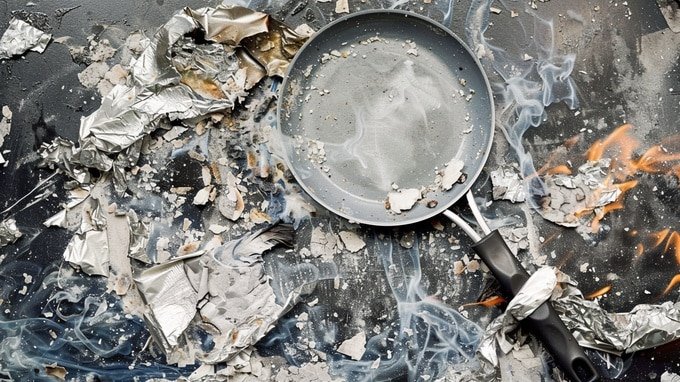
It’s vital to know that Teflon, the nonstick coating found on your pans, can become a concern when exposed to high temperatures. This coating, appreciated for its slick, food-releasing surface, can start to break down at temperatures above 500°F, releasing toxic fumes. These fumes, invisible and odorless, pose potential health risks, including temporary flu-like symptoms, known as polymer fume fever.
It’s worth noting that heat retention is essential in cooking, much like in the Presto Nomad slow cookers, to prevent overheating and maintain safety. Now, don’t let this scare you. These health risks are primarily associated with extreme conditions, such as leaving your pan unattended on a high heat for a prolonged time. It’s a risk, nonetheless, that needs attention and understanding.
So, what’re some prevention tips? First, never preheat an empty nonstick pan or use it on high heat. Lower temperatures will prolong the life of your pan and prevent overheating. Next, ensure good ventilation in your kitchen to disperse any possible fumes.
Incorporating these safety precautions can greatly reduce risks associated with Teflon pans. Remember, it’s about mindful usage and not the product itself that ultimately determines safety. Your well-being is paramount in your culinary journey, and understanding these risks is a step in the right direction.
Safe Cooking Practices
Taking into account the risks associated with overheating Teflon pans, you might be wondering how to ensure safety when using nonstick cookware. The key lies in adopting healthy cooking techniques that prioritize kitchen safety, temperature control, proper ventilation, and cookware maintenance.
When using nonstick pans, temperature control is vital. Avoid cranking up the heat to its maximum level. Instead, stick to medium or low heat settings. Remember, Teflon-coated pans heat up quickly and retain heat well. They’re not designed for high-heat cooking methods like searing or broiling.
Proper ventilation is another important factor when using traditional nonstick cookware. Always make sure your kitchen is well-ventilated when cooking. This helps dissipate any fumes that might be released, especially when the pan is overheated.
As for cookware maintenance, this involves caring for your nonstick pans to prolong their lifespan and performance. Use wooden or silicone utensils to prevent scratching the surface. After use, let the pan cool down before cleaning it to avoid thermal shock. Hand wash your nonstick pans with a soft sponge and mild detergent, avoiding harsh scrubbers or abrasive cleaning agents.
Exploring Cookware Alternatives
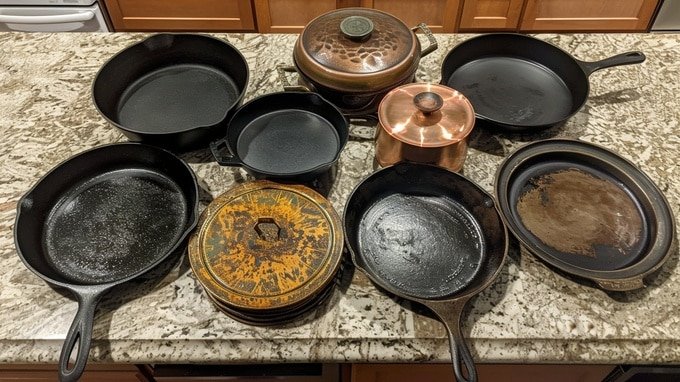
If you’re looking for alternatives to nonstick cookware, there’s a variety of other options that offer unique benefits. Let’s explore these cookware options and see how they stack up against the nonstick variety.
Firstly, consider the ceramic benefits. Ceramic cookware is non-reactive and heat-resistant. It doesn’t release any toxins, even at high temperatures, making it a safe and eco-friendly choice. It’s also easy to clean and doesn’t absorb odors or flavors from the food, which is a benefit of modern nonstick cookware.
Next, acknowledge the stainless durability. Stainless steel is tough, scratch-resistant, and can last a lifetime. It’s perfect for searing, browning, and deglazing, and it’s safe for use with metal utensils.
Now, let’s discuss cast iron benefits. This old-fashioned favorite is renowned for its excellent heat retention and distribution. It’s perfect for slow cooking and can be used both on the stove and in the oven.
Lastly, anodized cookware is your lightweight option. It’s just as durable as stainless steel, but much lighter. The anodized surface is also non-reactive and won’t alter your food’s taste.
Health Effects of PFAS
While considering different cookware options, it’s also important to understand the potential health impacts associated with certain materials. One such concern is PFAS exposure. You’ve probably heard about these synthetic chemicals, especially in relation to nonstick frying pans. They’re used because of their ability to resist heat, oil, grease, and water. But what happens when we’re exposed to them?
Research into the health risks associated with PFAS is ongoing. Some studies suggest potential links to high cholesterol, hormone disruption, and even certain types of cancer. However, the science isn’t conclusive yet, and more research is needed to fully understand the impacts.
Regulatory concerns about PFAS in cookware have been raised by bodies like the U.S. Consumer Product Safety Commission and the EPA. These organizations are pushing for more research and tighter regulations, to safeguard consumer health.
Meanwhile, FDA studies are looking into the safety of PFAS in nonstick cookware. They’re committed to understanding the potential risks and ensuring that the cookware you use in your home is safe. So, while the jury is still out on PFAS, it’s essential to stay informed and make choices that feel right for you.
Identifying Safe Cookware Options
Browsing the myriad of cookware options can sometimes feel overwhelming. The key is to understand the variety of cookware materials available, their heat resistance, cleaning methods, safety considerations, and environmental impact.
Stainless steel is a safe, durable option. It’s highly heat-resistant, easy to clean, and doesn’t leach harmful chemicals.
Cast-iron pans, though heavier, provide excellent heat distribution and retention. They’re virtually indestructible, but require special cleaning methods to prevent rusting.
Ceramic cookware is another safe choice. It’s non-reactive, meaning it won’t leach anything into your food. However, do check for lead and cadmium in glazes.
Anodized aluminum cookware, while lightweight and excellent at conducting heat, has a layer that prevents aluminum from leaching into food.
When it comes to environmental impact, consider the production and disposal processes. Steel and iron are recyclable, while Teflon pans aren’t. Ceramic and aluminum have mixed environmental impacts.
Frequently Asked Questions
How Often Should Nonstick Cookware Be Replaced for Safety Reasons?
You should replace your nonstick cookware every 3-5 years. Over time, the coating can deteriorate, potentially posing health risks. Factors like cooking techniques and care can impact its longevity. Stay safe and cook smart!
Can Nonstick Cookware Be Recycled or Safely Disposed Of?
Yes, you can recycle nonstick pans, but not in your curbside bin. Check local recycling options for safe disposal. Mind your environmental impact, consider reusable alternatives, and maintain your cookware properly to extend its lifespan.
Are There Any Food Items I Should Avoid Cooking in Nonstick Frying Pans?
You should avoid cooking acidic foods in nonstick pans. Also, don’t use metal utensils as they can cause the coating to flake. Always avoid high heat to prevent health risks from fumes.
How Does the Performance of Modern Nonstick Cookware Compare to Other Types?
You’ll find nonstick pans excel in ease of cleaning and cooking versatility. However, compared to cast iron or stainless steel, they may lack in durability and heat distribution. Price points vary depending on the quality and brand of pots and pans.
What Are Some Eco-Friendly Alternatives to Nonstick Cookware?
You’ve got great eco-friendly alternatives to nonstick cookware. Consider ceramic coatings, cast iron, stainless steel, carbon steel, or glass cookware. Each offers unique benefits and reduces environmental impact, making your kitchen greener.
Conclusion
Ultimately, it’s your kitchen, your health, your choice. Nonstick frying pans can be safe if used correctly, but overheating can pose risks. Alternatives like cast iron or stainless steel are worth exploring. Be mindful of PFOA and PFAS concerns, and make informed choices about your cookware. After all, the key to a healthy kitchen isn’t just about what you cook, but how you cook it. So, cook wisely, cook safely, and most importantly, cook with confidence.

